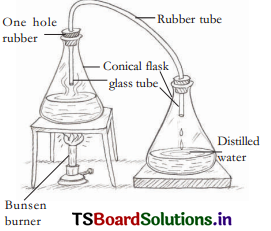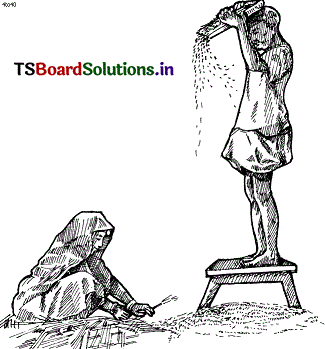Regular practice with TS 6th Class Science Bits with Answers 7th Lesson Separation of Substances improves students’ confidence and readiness for assessments and examinations.
TS 6th Class Science Bits 7th Lesson Separation of Substances
Question 1.
The components of Indian Ink can be identified using this technique
A) Filtration
B) Chromatography
C) Evaporation
D) Decantation
Answer:
B) Chromatography
![]()
Question 2.
Which of the following is not dissolved in water?
A) Sugar
B) Cooking oil
C) Salt
D) Lemon Juice
Answer:
B) Cooking oil
Question 3.
Concrete is a ……………..
A) mixture
B) man-made substance
C) natural product
D) A and B
Answer:
D) A and B
Question 4.
When the sugar falls in the red gram in your house, you separate the sugar by following
A) with magnet
B) sieving
C) sublimation
D) chromatography
Answer:
B) sieving
![]()
Question 5.
Which method helps to separate the husk from grain?
A) Grain and husk are equal in weight
B) Winnowing method
C) The weight of husk is less than the grain
D) None of the above
Answer:
C) The weight of husk is less than the grain
Question 6.
The impurities and bran present in flour can be removed by
A) Filtration
B) Evaporation
C) Churning
D) Sieving
Answer:
D) Sieving
Question 7.
Muddy water is taken in a beaker and allowed to stand. Then the mud settles down. The phenomenon is called (or) Mud and sand are separated from water by using this method.
A) Decantation
B) Sedimentation
C) Evaporation
D) Winnowing
Answer:
B) Sedimentation
Question 8.
Sand and salt are separated from its mixture using the principle
A) decantation and then evaporation
B) evaporation and then decantation
C) evaporation and condensation
D) sieving and winnowing
Answer:
A) decantation and then evaporation
Question 9.
Sieving is used when components of mixture have
A) same particle size
B) different particle sizes
C) same or different particle sizes
D) none
Answer:
B) different particle sizes
Question 10.
Your mother adds the following ingredients for smell while cooking biryani
A) Dal-Chilli powder
B) Onions – Dal
C) Cloves – Cardamom
D) Salt-Chilli powder
Answer:
C) Cloves – Cardamom
![]()
Question 11.
If crystallization process is not done in the nature, we can’t obtain…
A) Sea water
B) Sugar from sugarcane
C) Salt from sea water
D) Urea from crop
Answer:
C) Salt from sea water
Question 12.
The method of ……….. is used in the process of preparing cheese (paneer) in our houses.
A) decantation
B) filtration
C) sublimation
D) crystallisation
Answer:
B) filtration
Question 13.
Salt is separated from salt water by
A) crystallisation
B) filtration
C) sedimentation
D) sieving
Answer:
A) crystallisation
Question 14.
The reverse process of ‘evaporation’ is
A) filtration
B) decantation
C) boiling
D) condensation
Answer:
D) condensation
Question 15.
When the heavier component of a mixture settles down after water is added to it is called ……….
A) Sublimation
B) Filteration
C) Sedimentation
D) Crystallisation
Answer:
C) Sedimentation
![]()
Question 16.
Impurities settle at the bottom when muddy water was kept over night in a bucket. The clear water was then poured off from the top. The
process of separation used in this example is called
A) Filteration
B) Decantation
C) Winnowing
D) Sublimation
Answer:
B) Decantation
Question 17.
Separation of colours from a mixture of colours is called …….
A) Sublimation
B) Chromatography
C) Decantation
D) Crystallization
Answer:
B) Chromatography
Question 18.
Chromatography: colour: sedimentation ………
A) sand and mud
B) husk and paddy
C) flour and sugar
D) sugar and salt
Answer:
A) sand and mud
Question 19.
Find out the odd one regarding separation of mixture
A) Sublimation
B) Rectification
C) Crystallization
D) Distillation
Answer:
B) Rectification
Question 20.
If oil is mixed with water, how can you separate it?
A) by sublimation
B) by decantation
C) by sedimentation
D) by filtration
Answer:
D) by filtration
Question 21.
The result of conducting Chromatography is ……….
A) All colours are mixed
B) Colours are separated
C) New colours are formed without separation
D) No change observed
Answer:
B) Colours are separated
![]()
Question 22.
The following method is used to separate colour from the mixture
A) Sedimentation
B) Filtration
C) Chromatography
D) Winnowing
Answer:
C) Chromatography
Question 23.
Mud is separated by this process
A) Sedimentation
B) Winnowing
C) Crystallisation
D) Distillation
Answer:
A) Sedimentation
Question 24.
Identify the correct sentence.
A) Colours are separated by chlorography
B) Colours are separated by chromatography
C) Colours are separated by achlorography
D) Colours are separated by chromography
Answer:
B) Colours are separated by chromatography
Question 25.
Match the following.
a) Hand picking ( ) i) Soil and water separation
b) Sedimentation ( ) ii) Husk from grain
c) Winnowing ( ) iii) Stones from rice
A) a-i, b-ii, c-iii
B) a-iii, b-ii, c-i
C) a-ii, b-iii, c-i
D) a-iii, b-i, c-ii
Answer:
B) Colours are separated by chromatography
Question 26.
Mixture of substances present in the coffee.
A) Coffee powder, water, sugar, milk
B) Salt, water, coffee powder
C) Salt, water, coffee powder
D) Salt, sugar water, coffee powder
Answer:
A) Coffee powder, water, sugar, milk
Question 27.
Match the following.
a) Crystallisation ( ) i) Prepare pure water
b) Distillation ( ) ii) Camphor vapourisation
c) Sublimation ( ) iii) Salt from water
A) a – i,b – ii,c – iii
B) a – iii,b – i,c – ii
C) a – ii,b – i,c – iii
D) a – i,b – iii,c – ii
Answer:
B) a – iii,b – i,c – ii
Question 28.
Read the following sentences. Find the correct sentences.
i) Chromatography is done with chalk piece
ii) Sublimation is the technique for salt and water
iii) We can separate stones and paddy from rice
iv) Winnowing helps us to separate husk from grain
A) i, ii, iii
B) i, iii, iv
C) i, iii only
D) ii, iii, iv
Answer:
B) i, iii, iv
Question 29.
Substances that are mixed in lemon water.
A) lemon juice
B) salt or sugar
C) water
D) all the above
Answer:
D) all the above
Question 30.
One of the following is not a man-made substance
A) laddu
B) animal body
C) jam
D) curd
Answer:
B) animal body
![]()
Question 31.
Find out the wrong statement.
A) Husk is separated from grain by winnowing
B) Flour is separated from red gram by crystallisation
C) Stones are separated from rice by hand picking
D) Salt is obtained by evaporation of sea water.
Answer:
B) Flour is separated from red gram by crystallisation
Question 32.
Identify the correct statement of the following.
I) Salt is separated from salt solution by crystallization.
Il) Sugar is separated from tea by filtration.
A) I, Il are correct
B) I, II are not correct
C) I is correct, is not correct
D) I is not correct,is correct
Answer:
C) I is correct, is not correct
Question 33.
The correct question to clarify doubt on distillation.
A) How can we use drinking water?
B) What material is used for chromatography to get distilled water?
C) How can we get distilled water?
D) A or B
Answer:
C) How can we get distilled water?
Question 34.
What will be the consequence if there is no crystallisatlon in the nature?
A) We can’t find the colours
B) We can’t get distilled water
C) We can’t separate pure rice
D) We can’t get salt from sea water
Answer:
D) We can’t get salt from sea water
Question 35.
Find the odd one out regarding mixtures of substances.
A) Coffee
B) Tea
C) Lemon Juice
D) Water
Answer:
D) Water
Question 36.
Read the given sentences.
Lakshmi says that sedimentation and decantation are used at home while cleaning
rice and pulses for cooking.
A) Sentence is wrong based on the process
B) Sentence is correct based on the process
C) Sentence is incomplete based on the method
D) Sentence gave wrong information
Answer:
A) Sentence is wrong based on the process
Question 37.
Read the given sentences.
a) Chromatography is used to separate the colours
b) Camphor is vapourised by sublimation
A) Both the sentences are wrong
B) (a) is correct (b) is wrong
C) (b) is correct (a) is correct
D) Both the sentences are correct
Answer:
D) Both the sentences are correct
![]()
Question 38.
Filter paper for mud water. Then what is for chromatography?
A) Chalk powder
B) Funnel
C) Chalk piece
D) Sieve plate
Answer:
C) Chalk piece
Question 39.
When a few plants are Infested …………… is an excellent method of controlling pests.
A) hand picking
B) crystallization
C) chromatography
D) sedimentation
Answer:
A) hand picking
Question 40.
How can you separate stones, the mixture combining pebbles and other organic matter?
A) distillation
B) crystallization
C) decantation
D) hand picking
Answer:
D) hand picking
Read the given paragraph and answer the question:
On a windy day, a farmer stands on a high platform and allows the mixture of grain and husk to drop slowly from the flat pan. The wind carries the husk forward and the grain fall vertically downward. A separate heap of grain is formed.
Question 41.
Which method of separation is explained in the given paragraph?
A) sieving
B) flat falling
C) winnowing
D) hand moving
Answer:
C) winnowing
Question 42.
A filter paper can be used to separate
A) salt from salt solution
B) seeds and solid particles of pulp in the vegetable juice
C) muddy particles from muddy water
D) decoction from boiled tea leaves.
Answer:
B) seeds and solid particles of pulp in the vegetable juice
Question 43.
The method commonly employed by farmers to separate husk from grains is
A) sieving
B) threshing
C) winnowing
D) hand picking
Answer:
D) hand picking
Question 44.
Camphor and powdered salt mixture is separated by
A) sublimation
B) filtration
C) winnowing
D) chromatography
Answer:
A) sublimation
![]()
Question 45.
On large scale, milk or curd is to separate the butter.
A) hand picked
B) centrifuged
C) decanted
D) filtered
Answer:
B) centrifuged
Question 46.
The principle in the process of sedimentation is
A) Gravity
B) Attraction
C) Repulsion
D) Condensation
Answer:
A) Gravity
Question 47.
Find out the correct order of an experiment
a) Pour some water in a plate
b) Take a whole stick of white chalk
c) Observe the colour pattern formed on chalk
d) Put an ink mark on the curved surface of chalk
Chalk is placed in the water
A) b, d, a, e, c
B) a, e, c, d, b
C) d, c, e, b, a
D) c, e, b, a, d
Answer:
A) b, d, a, e, c
![]()
Question 48.
When you kept the camphor in open air, it disappears after some hours. Name the phenomenon.
A) Sublimation
B) Distillation
C) Crystallization
D) Evaporation
Answer:
A) Sublimation
Question 49.
Find the part in the given diagram of chromatography?

A) Chalk mark
B) Ink mark
C) Water mark
D) Oil mark
Answer:
B) Ink mark
Question 50.
What is the purpose of keeping cotton ply at the end of the funnel?

A) To prevent loss of vapourised camphor
B) To release loss of vapourised camphor
C) To stop solid camphor from escaping
D) To prevent loss of heat
Answer:
A) To prevent loss of vapourised camphor
Question 51.
The conical flask receiving water from heated conical flask in the distillation process is .
A) With full of impurities
B) With full of salt
C) With full of crystals
D) Without impurities
Answer:
D) Without impurities
Question 52.
The leaves are separated from the tea by the method of
A) Chromatography
B) Sieving
C) Hand picking
D) Filtration
Answer:
D) Filtration
Question 53.
What process is involved in the sublimation?
A) Changing from solid state to gaseous state
B) Changing from liquid state to solid state
C) Changing from gaseous state to liquid state
D) Changing from liquids to gaseous state
Answer:
A) Changing from solid state to gaseous state
Question 54.
Find out the correct order of an experiment
a) Stir the solution with a glass rod.
b) You will find salt crystals and powder in the dish
c) Heat some salt water in a beaker
d) Continue heating till all the water in the beacker has evaporated
A) c, a, d, b
B) d, a, b, c
C) a, c, d, b
D) d, c, b, a
Answer:
A) c, a, d, b
Question 55.
Which substance is used instead of water to do evaporation experiment?
A) Sand
B) Soda water
C) Rice
D) Piece of chalk
Answer:
B) Soda water
![]()
Question 56.
The process of separation of sugar and flour is
A) Filtration
B) Sieving
C) Winnowing
D) Chromatography
Answer:
B) Sieving
Question 57.
Which substance given below undergoes sublimation
A) camphor
B) water
C) kerosene
D) crystal violet
Answer:
A) camphor
Question 58.
Generally we see sublimation process here in our surroúndings
A) lighting camphor in the temples
B) incense sticks formers
C) salt crystallization
D) drinking water
Answer:
A) lighting camphor in the temples
Question 59.
People prefer ………… and methods at home to clean rice and pulses for cooking
A) sedimentation, sublimation
B) sublimation, distillation
C) distillation, crystallisation
D) sedimentation, decantation
Answer:
D) sedimentation, decantation
Read the given lines.
Before administering injections to patients, doctors mix injection powder with some liquid.
Question 60.
What is the liquid along with injections used by doctors?
A) Filtration
B) Distilled water
C) Boiled water
D) Mud water
Answer:
B) Distilled water
Question 61.
Sublimation — Camphor
Crystallisation — Sea water
Winnowing — Husk from gram
What do we get from salt water by the process of Crystallisation?
A) Salt
B) Soil
C) Water
D) Rocks
Answer:
A) Salt
![]()
Read the given lines.
Filter paper is a sieve made of paper which has very fine holes. We can filter very small particles using this type of sieve.
Question 62.
What method is done to separate flour from mustard seeds?
A) Sedimentation
B) Distillation
C) Sieving
D) Decantation
Answer:
C) Sieving
Question 63.
Given picture shows heating of camphor on ……….

A) sublimation
B) sedimentation
C) crystallization
D) distillation
Answer:
A) sublimation
Question 64.
The given picture explains the process of …………….

A) sublimation
B) filtration
C) chromatography
D) sublimation
Answer:
C) chromatography
Question 65.
What is done through the apparatus shown In the given picture?

A) decantation
B) decantation
C) sedimentation
D) crystallisation
Answer:
B) decantation
Question 66.
I Identify the figure.
A) Sedimentation
B) Decantation
C) Crystallization
D) Distillation
Answer:
B) Decantation
Question 67.
The process which is shown in the diagram is …………..

A) Chromatography
B) Hand picking
C) Sieving
D) Winnowing
Answer:
C) Sieving
Question 68.
The experiment indicated in the following diagram.

A) Preparation of distilled water
B) Sublimation
C) Condensation of sugar
D) Preparation of salt water
Answer:
A) Preparation of distilled water
Question 69.
What is the man doing in the picture?

A) Decantation
B) Distillation
C) Winnowing
D) Chromatography
Answer:
C) Winnowing
Question 70.
For administering injections doctors use
A) Salt water
B) Distilled water
C) Sea water
D) Sugar water
Answer:
B) Distilled water
![]()
Question 71.
One of the following is not a hand picking technique.
A) Stones from rice
B) Rotten fruits from fresh fruits
C) Separating oranges and apples
D) Separate husk from grains
Answer:
D) Separate husk from grains
Question 72.
Different types of separation techniques help us
A) to get desirable quantities of material
B) to remove good varieties
C) to get undesirable material
D) to follow various techniques
Answer:
A) to get desirable quantities of material